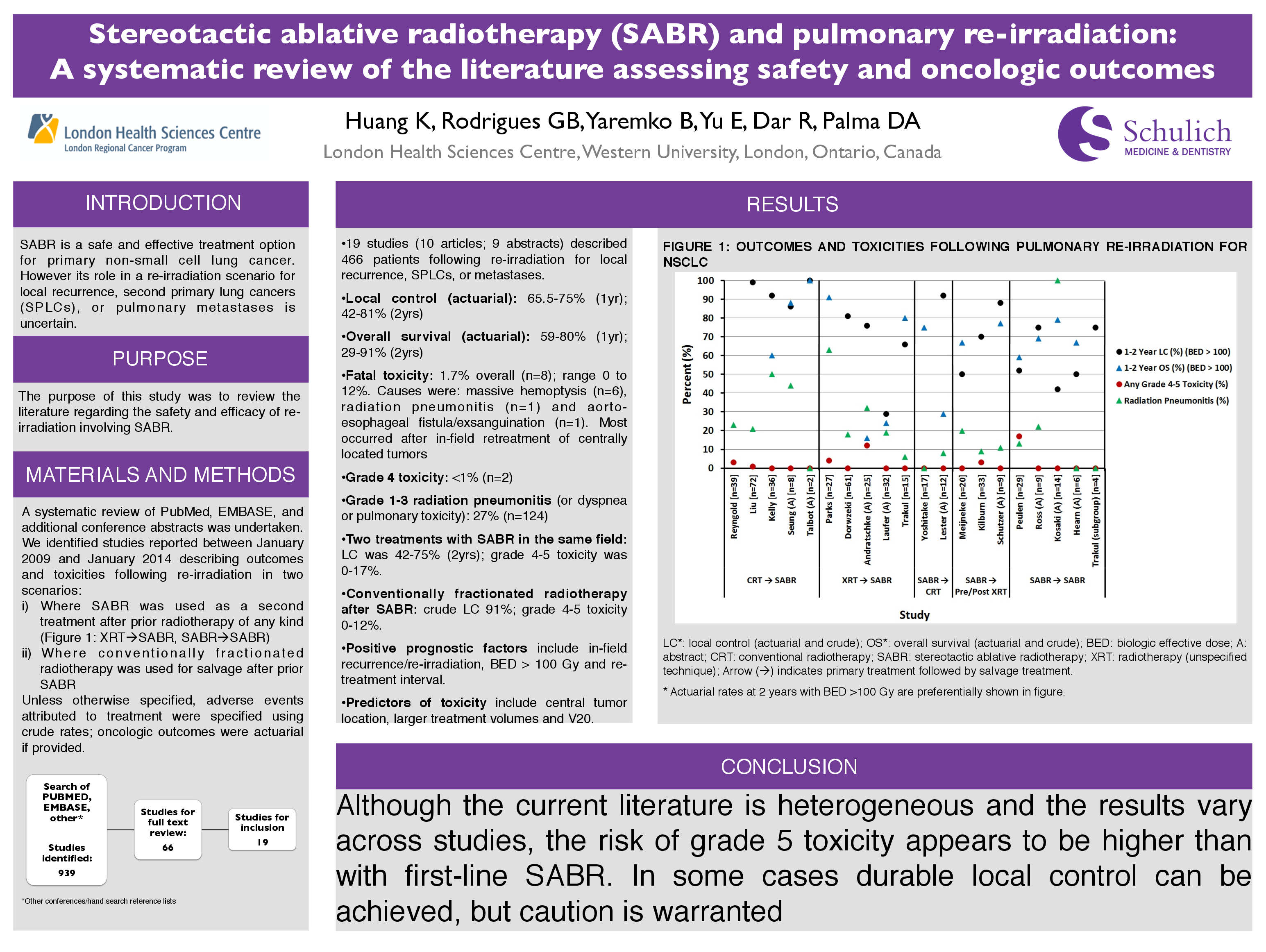Abstract
Kitty Huang, George Rodrigues, Brian Yaremko, Edward Yu, Rashid Dar, David Palma
London Regional Cancer Program, London, ON
Purpose: SABR is a safe and effective treatment option for primary non-small cell lung cancer. However its role in a re-irradiation scenario for local recurrence, second primary lung cancers (SPLCs), or pulmonary metastases is uncertain. The purpose of this study was to review the literature regarding the safety and efficacy of re-irradiation involving SABR.
Materials and Methods: A systematic review of PubMed, EMBASE, and additional conference abstracts was undertaken. We identified studies reported between January 2009 and January 2014 describing outcomes and toxicities following re-irradiation in two scenarios: 1) where SABR was used as a second treatment after prior radiotherapy of any kind; and 2) where conventionally fractionated radiotherapy was used for salvage after prior SABR. Reference lists of included studies were hand-searched. For each data source, the number of studies meeting search criteria, selected for full text review, and selected for final inclusion were as follows: PubMed 472, 39, and 10 respectively; EMBASE 464, 24, and 8 respectively, ‘other conferences’ 3, 3 and 1. Adverse events were attributed to treatment unless otherwise specified in the source article and were specified using crude rates; oncologic outcomes were actuarial.
Results: Nineteen studies (including 10 articles and nine abstracts) described 466 patients following re-irradiation for local recurrence, SPLCs, or metastatic lung tumours. Reported local control (LC) rates ranged from 65.5-75% (one year) and 27-75% (two years). Overall survival (OS) ranged from 59-80% (one year) and 29-91% (two years), the latter in a subgroup receiving SABR with BED >100 Gy. Fatal toxicity was reported in eight of 466 patients (1.7%). This ranged from 0 to 12% across all studies and consisted of massive hemoptysis (n=6), radiation pneumonitis (n=1) and aorto-esophageal fistula/exsanguination (n=1). In-field retreatment of centrally located tumours accounted for at least half of all Grade 5 toxicity. Grade 4 toxicity was reported in two patients (<1%) and Grade 1-3 radiation pneumonitis (also reported as dyspnea or pulmonary toxicity) were reported in 124 patients (27%). For patients receiving two treatments with SABR in the same field, LC was 42-75% (two years) and the rate of Grade 4-5 toxicity was 0-17%. Patients treated by conventionally fractionated radiotherapy after SABR had a crude LC rate of 91% and Grade 4-5 toxicity rate of 0-12%. Overall, positive prognostic factors include in-field recurrence/re-irradiation, BED >100 Gy and shorter re-treatment interval. Predictors of toxicity include central tumour location, larger treatment volumes and V20.
Conclusions: Although the current literature is heterogeneous and the results vary across studies, the risk of Grade 5 toxicity appears to be higher than with first-line SABR; however, in some cases durable local control can be achieved.





